In the animation class I am taking, one of the first lessons on developing a character to animate, is to think about how the character stands. To develop the character through posture.
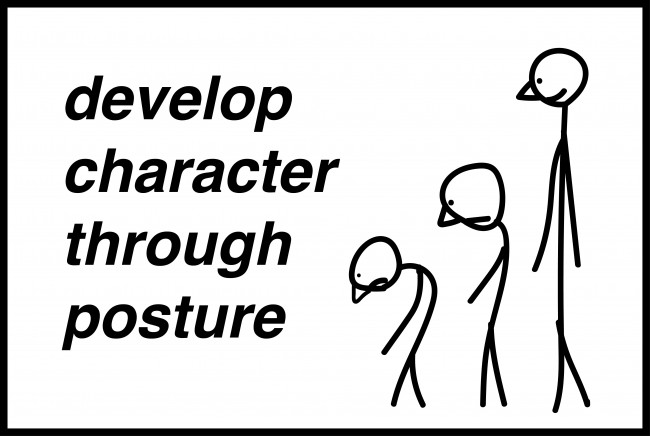
How does your character stand?
The animation class has helped me develop a character in a story by having to show the person's character in a drawing.
While I was developing a character to draw, I realized the essence of a person is in their posture. Are their shoulders squared or slouched? Does the character have a straight back or is their posture stooped? How do they stand? Do they put weight on both feet equally or do they lean to one side?
What is the definition of posture?
It is time to get Big Red off of the book shelf again. On page 1025 of the New College Edition of The American Heritage Dictionary of the English Language, posture is found neatly between postulator and postvocalic. Definition of posture: A position or attitude of the body or of bodily parts: A characteristic way of bearing one's body, especially the trunk and head.
Show, don't tell
I know you have read this ten million times. Okay, maybe not ten million times. Maybe you have read this five million times. Maybe you have tattooed, “Show, don't Tell.” on the outside of your left arm, so you can read it while you write your novel.
Today, I am telling you one more time. Now, you have read it ten million and one times. Show, don't tell. However, today is different. I am only giving you the option to show with a drawing first. Yes, a bit silly. A writing blog, and I am not letting you write about your character first.
Draw your Character
Step One: Show with a drawing.
Step Two: Show with words.
Well, I will let you write about your character, just not right away. First I want you to draw your character. After you draw your character, then you can write about them. Show with a drawing first, then show with words. Stick figures are great. A person who stands up straight and tall, would be a stick standing straight up. And someone who is sad, could have a stick that is slumped.
The only way you are allowed to develop your character right now is to draw them. Yes, that's right. You have to draw your character. You have to show me who they are by their posture. How they stand. How they hold their head. Do they look me right in the eye, or do they gaze at the ground when they are talking to me.
In animation, I can't tell you my character is sad by writing, “She is sad.” While I am developing the character, there is no dialog. The only way I can show you, the viewer, that the character I drew is sad—is to draw her body looking sad. Perhaps her head is bent, her posture is slumped. Maybe her head is in her hands.
Limiting our options, taking away words, and only relying on what we see with our eyes, will help develop our ability to describe our character.
You are not allowed to say, “She was sad, or he was angry.”
You have to show me in your drawing first.
We are learning through limiting our choices. There is no tell, there is only show.
Postures and Suggested Meanings
A straight back could mean the person is confident, or it could mean they had back surgery and have no other option but to stand straight.
Stooped shoulders could show lack of confidence, or maybe the person grew up in a home with four-foot ceilings and they became stooped from walking for years in a home with low ceilings.
Arms crossed could mean a person is angry or it could mean they are cold.
Think about other body gestures and their possible meanings.
I photographed a blind man for a book of portraits I made of all the people who lived in my tenement building. He was the only person whose hands were on his knees reaching out to me. Everyone else in the book who were sighted, had their hands closer to their body.

What is Their Posture?
Items to consider when you think about your characters posture.
1. Head size and placement: Lowered head, chin up or down.
2. Shape of their shoulders, round, square, relaxed, stiff,
3. Are they leaning to one side?
4. Position of the legs, broad stance or narrow. Pigeon-toed or are the knees together?
5. Where are the hands? On the hips, holding something, in their hair?
6. Are they big? little? Tall, short? How do they stand?
7. Does the person carry all of their extra weight in their stomach or in their thighs?
8. Are they muscular or thin? Are they flexing their muscles, or are their skinny arms held timidly to their chest?
9. How do they hold their head? Upright? Downcast? What does their head position say about their character?
10. What is your character feeling? Show their feelings by how they stand. What is their posture?

Field Trip Idea
Go to a coffee shop, a park, or the lobby in a hotel and observe the body language of the people. How are they sitting? Do they sit up straight? Are they slouched? Is their someone with them? What is the posture of the couple sitting together? Do they lean into each other or do lean away? Are they talking or checking the status updates on their phone?
We can learn about character development through observing people and their posture. Try not to stare. Be discreet. But observe.
Have you ever tried to tried to study character development by observing people in public? Please let me know in the comments section.
PRACTICE
Today, take fifteen minutes to work on character development through the study of posture. You can work on a character you have already written about, are working on, or a new character. Think about the characters posture and what you want to show by how they stand or sit.
What does the posture show the reader?
After you have thought about the posture through your drawing, then, and only then write what the character is feeling. I hope this exercise of limiting your observation to only showing with a drawing at first, will help you “show and not tell,” with your writing.
Step One: Show with a drawing.
Step Two: Show with words.
As always, I love to hear from you. Please share your writing in the comments and don't forget to share some love with your fellow writers.
xo
Pamela
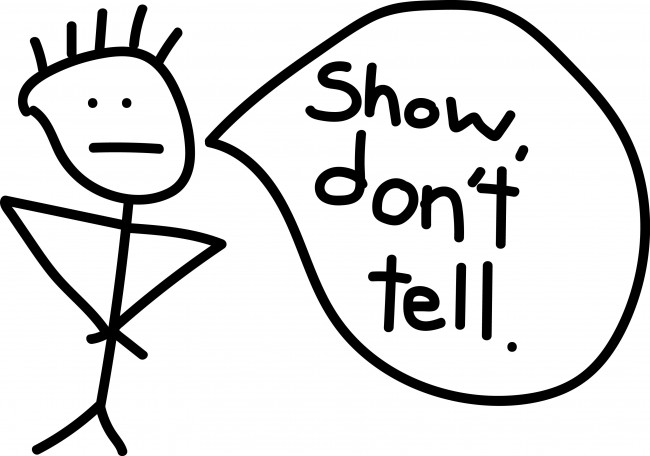
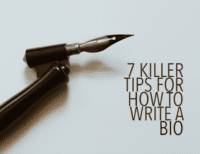

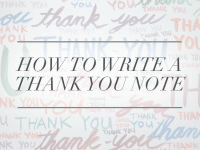
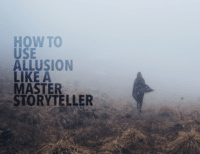



Thank you for this. I have two characters for whom standing upright is very much a part of their characters and I just realized the subtle differences between them, today.
Hello Jon Carl Lewis,
You are very welcome. Your characters sound very interesting. Isn’t it amazing how just the tilt of a person’s head can show their character? Please let us know how your story is developing.
xo
Pamela
Will do. Thanks!
Ok, this is the most fun blog I have read in a while. Super helpful and I look forward to putting it into practice. Thanks so much!
Hello Christal,
I am so happy you like this writing blog. This is where I write every second Tuesday. Joe, the editor, has different authors writing each day. If you ever want to do the prompts there is a nice community of readers to read your writing prompt practice.
You are very welcome.
xo
Pamela
Thank you Pamela! I love your humor. I’ve been trying to figure out how to describe my husband while in the hospital after brain surgery and therapy. I always knew I was a visual person but didn’t realize that stick figures were away of seeing his posture…and mine while going through this with him. I’m working on a memoir and again I thank you for sharing.
Hello Cheryl,
May I ask how your husband is doing? I pray he is feeling better and therapy is going well. And that you are feeling well as well. It must be hard when someone you love has major surgery.
I am glad this story helped you see your posture during the hospitalization and recovery, and I love that you love my humor. My kids just groan.
Please let me know how your memoir is going. Marion Roach Smith wrote a great book about writing memoir. Here is an article sharing tips from her book,
“The Memoir Project.” https://thewritepractice.com/19-tips-on-writing-memoir-from-the-memoir-project-by-marion-roach-smith/
And an interview with Marion by my cat.
https://thewritepractice.com/how-to-write-a-memoir-cat-talk/
All my best,
xo
Pamela
Hi Pamela,
Thanks for your reply. My husband survived the removal of a golf ball size brain tumor and later a brain infection. He spent two and half months in the hospital which included weeks of therapy. This all happened in the summer of 2014. I’d like my memoir to reflect the brighter side of survival rather than the doom and gloom of a 50/50 chance of not surviving.
Thank you for the link to the article. I will certainly read it.
All the best to you too.
Cheryl
yes…yes…yes – the brighter side of survival.
My goodness what a life event you and your husband went through. So glad to hear things are fine.
I love your idea of using Pamela’s sketching technique for reflecting on your husband’s time in the hospital.
Thank you Susan W A for your support.
Cheryl
Best wishes for him, and I’m sure he’ll get better soon. There are lovely caring people who try their best to help. Hang in there: when things are tough, just remember that this too shall pass! There’s always a happy ending, in life and in stories.
Thank you Rosie…I appreciate your comment.
Cheryl
Hello Pamela! I loved Harper’s blog posts: well done for teaching her! 🙂 She really is hilarious, and so are you. (I think we all just groan at our mums’ humour: don’t take it personally if your kids don’t laugh.)
Loved your post, as usual. It reminded me of an observation I once made in a restaurant. A certain young lady paraded around the room, her nose in the air, looking at no one and portraying herself as a general snob. When she sat down, however, her shoulders slumped, her elbows drew together, and her chin went down. I realized then that one can be arrogant without being confident. Whether or not that was the case, her body language made a strong statement.
Hi Victoria,
Smile. 🙂
Your observation of the lady in the restaurant reminds me what people aren’t always what they seem to be.
In a story we can have a character acting confidently parading around the room, and then show them late in private with different body language. Your story was a great example of showing.
xo
Pamela
I wrote two pieces from the perspectives of my WIP’s main characters, about each other. As always, reviews are much appreciated!
Alex’s POV
The weird thing about Alicia – well, there are lots of weird things about Alicia, but this one in particular – is that even though she always sticks out like a sore thumb, she still manages to look like she owns the place. She’s skinny and tall, and while most people that are built like that are just gangly and awkward, she has this easy sort of grace. I’ve noticed by now that she has a technique for pulling it off. She leans back on the nearest available surface – not slouching, she never slouches, just easily leaning back on her heels – crosses her feet at the ankles, folds her arms, and tilts her head to the right at a roughly 30° angle. It gives her a quality of “effortlessly cool” that yeah, okay, I’m kind of jealous of. She gives off waves of confidence like old ladies give off waves of stinky perfume. I’m starting to wonder though, the more I get to know her – how much of that
confidence is real, and how much is carefully built armor against the world?
Alicia’s POV
The curious thing about Alex – well, there are many curious things about Alex, but this one in particular – is that even though she is always far and away the most interesting person in any room she occupies, she always attempts to make the space she inhabits as small as possible. If she must stand, it’s in the corner. When she sits she crosses her legs, hunches her shoulders, and angles her head slightly downwards. In fact, she is almost always looking down, even when she’s walking. It’s a wonder she isn’t constantly running into trees. I have observed, however, that her eyes – startlingly blue; they’re more than a little fascinating and I must remind myself constantly not to stare – frequently peer up through her bangs and dart around, taking note of what’s around her before she looks away. I believe she notices more than others realize. Perhaps more than she herself realizes. It’s a mystery to me why an individual who is clearly so singular goes to so much trouble to hide herself. A mystery that hopefully I will be able to solve.
Both characters come to life. You have great observations. I’m jealous of the way you use details about your characters’ appearances to show them to us, and using that to lead us to so much more about them than “teling” ever could.
This is a great idea to draw the character first. I often wonder, when I am writing, whether I have described my character enough so the reader would have the same picture as I do. And sometimes, my character evolves as I describe them. Having a sketch to work from will help me focus on my vision.
Thanks so much for sharing this. I’m saving this post for my next writing session.
http://Runwright.net
I use posture a lot in my book. I do believe by use of this, you can make your character more real and believable. I love breathing life into all my characters and not only do I use posture, I use gestures -whether they are gesturing with their heads or hands. And I love playing around with facial expressions as well and use all of the above in dialogue as well. It really brings in a sense of reality.
Environment: micro-gravity or free fall. They float, they do not lean, they do not stand. They do not walk, anywhere with a purpose, because they do not walk. Remember they float. They use hand rails to push off or grab on to. Body shape? Spherical, from growing up in micro-gravity. Physically fit, just spherical in shape, they play a form of hand ball, faster and with more energy, than anything seen on Earth.
Interesting.
What are these floating beings? I want to know more!
Human beings, but two or three generations in space. Those that spend most of their time in micro-gravity will have drifted from the norm.
I was thrilled to get this assignment as I have been trying to focus on my villain. I just have not been able to “see” him. This was just the exercise I needed. Now that I can see him I have a better idea of who is and what makes him so bad. This is very much a rough draft. I wrote for 15 minutes and then corrected the grammar and the spelling, but I can see how this will get me to a full-blown character. Thank you!
Here goes:
Sal’s posture
Salvadore Guado brought his roughly 5’9’’ to an upright position. It did not take all that much doing despite
being well into his fifties and getting nearly, well actually, no exercise at
all, that is unless you could count lifting whiskey and bourbon glasses and counting
money. In general his frame was erect, although his shoulders stooped slightly
in side his suit. Today’s being a darker shade of brown or taupe than usual.
Although he knew most lawyers wore black or dark blue suits, he thought that
was cliché and avoided them whenever possible, sticking to browns, tans and
taupes. No matter that black and dark blue were seen as more trustworthy and “normal”,
almost a uniform. Sal regarded himself
as smart and savvy enough to pull off a brown suit. His deep-set brown eyes
seemed larger and more noticeable in brown. Giving him a more human and
approachable look to his somewhat sullen features. Sal thought he looked
chiseled, but the grey patches of his face really gave him a sunken, nearly
shriveled look. Honesty was not really
emblazoned over his face, although he did have a way of exuding warmth and a
charm that immediately put one at ease.
Most people that met him carried the impressions received in the first
five minutes well into their ongoing relationship with them. Certainly, this
gentle caring grand-father of a man that did not know lawyers wore navy blue
was a man that could be trusted and would never betray their loyalty.
~~~ end for now …
Hi Pamela. I love posts about what I call “micro issues” in writing, as they are meta-important!! Thank you so much for this. I sent it to my writing students in the class I am currently teaching. Deena
Here’s my practice. I did do a stick figure sketch of the scene before writing this.
7:56 a.m. Some rush with burrowed brows, head leading body. Some gaze down, shoulders sag, weighed down by the complicated ponderings of adolescence or the looming specter of “(e) All of the above.” Some whizzzzz downhill, sliding past cars, curving into the driveway, clanking chains and locks to hold in place. Some carry their slumber with them, eyes half-closed, loose clothes indistinguishable from those slept in. Some cavort in groups of two, three boys, two, three girls near the trunk of a car, starting on their way by twos, prancing back to catch the end of a new conversation, eyes smiling. Mine shares a soft, “Thank you. Love you, too,” as the car door retakes its place. He moves with straight and supple, lithe and muscular lines, soles landing lightly on the ground, advancing effortlessly as on the moving sidewalk in an airport; subtle swing of one arm, the other less so with the weight of a notebook and book; gaze forward, ready to acknowledge; eyes and smile sparkle with the glimpse of friends.
This is from my observation of the few minutes before the bell rings at my son’s high school.
Funny, I almost always draw a character before I start to write about them. (I would say I’m as much a doodler as I am a story-scribbler.) I feel as though it’s much easier to understand a character and write about them after I’ve made a few sketches of them. For example, the main character of my book isn’t very confident, but she’s still a little feisty. In her first character sketch, I have her supporting her weight on one foot, her arms folded across her chest. She looks off to the side with a slight frown.
Another character, one of the antagonists, is drawn standing straight, his chin raised so that he is literally looking down at the viewer.
The advice you give is very good, and I think that even if someone isn’t particularly skilled when it comes to drawing, they still can learn a lot by stick-figure doodles of their characters, as you suggested. :3